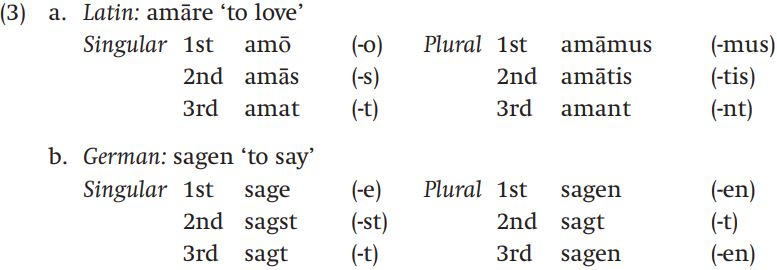


 Grammar
Grammar
 Tenses
Tenses
 Present
Present
 Past
Past
 Future
Future
 Parts Of Speech
Parts Of Speech
 Nouns
Nouns
 Verbs
Verbs
 Adverbs
Adverbs
 Adjectives
Adjectives
 Pronouns
Pronouns
 Pre Position
Pre Position
 Preposition by function
Preposition by function 
 Preposition by construction
Preposition by construction
 Conjunctions
Conjunctions
 Interjections
Interjections
 Grammar Rules
Grammar Rules
 Linguistics
Linguistics
 Semantics
Semantics
 Pragmatics
Pragmatics
 Reading Comprehension
Reading Comprehension|
Read More
Date: 14-1-2022
Date: 2023-11-08
Date: 2023-08-31
|
Students of Indo-European languages like Latin or German, know that verbs in those languages are marked for the inflectional category of person: that is, verbs exhibit different endings depending on whether the subject of the sentence is the speaker (first person), the hearer (second person), or someone else (third person); frequently number is also expressed as well as person:

Speakers of Indo-European languages may, however, be less familiar with marking person on nouns. It is not unusual for languages to mark person on nouns to show possession, something we do in English with separate possessive pronouns. For example, the Iroquoian language Mohawk uses prefixes to mark person on nouns:

Mohawk, and other languages also show another kind of person marking that we don’t have in English, making a distinction between the inclusive and exclusive forms of the first person plural. In an inclusive form, the speaker includes herself and the hearer. In the exclusive form, the speaker includes herself and others, but not the hearer. So the inclusive form of the first person could be thought of as a combination of first and second person marking, and the exclusive as a combination of first and third person marking. This distinction can be marked in Mohawk as well, specifically with prefixes on verbs:

As we mentioned above, it is also possible to mark verbs if the subject consists of exactly two people. So in addition to the inclusive and exclusive forms in (5), Mohawk also has first person dual inclusive and exclusive forms :(Mithun 1999: 70):

English verb forms are ambiguous with respect to these distinctions. If I say “we write,” neither the form of the verb nor the form of the pronoun makes explicit whether the hearer is included or not, or how many other than the speaker are involved (although of course we can make the distinction in a round-about way, if we need to!).
|
|
|
|
"عادة ليلية" قد تكون المفتاح للوقاية من الخرف
|
|
|
|
|
|
|
ممتص الصدمات: طريقة عمله وأهميته وأبرز علامات تلفه
|
|
|
|
|
|
|
المجمع العلمي للقرآن الكريم يقيم جلسة حوارية لطلبة جامعة الكوفة
|
|
|